
What’s Included: Research Paper Template
If you’re preparing to write an academic research paper, our free research paper template is the perfect starting point. In the template, we cover every section step by step, with clear, straightforward explanations and examples .
The template’s structure is based on the tried and trusted best-practice format for formal academic research papers. The template structure reflects the overall research process, ensuring your paper will have a smooth, logical flow from chapter to chapter.
The research paper template covers the following core sections:
- The title page/cover page
- Abstract (sometimes also called the executive summary)
- Section 1: Introduction
- Section 2: Literature review
- Section 3: Methodology
- Section 4: Findings /results
- Section 5: Discussion
- Section 6: Conclusion
- Reference list
Each section is explained in plain, straightforward language , followed by an overview of the key elements that you need to cover within each section. We’ve also included links to free resources to help you understand how to write each section.
The cleanly formatted Google Doc can be downloaded as a fully editable MS Word Document (DOCX format), so you can use it as-is or convert it to LaTeX.
FAQs: Research Paper Template
What format is the template (doc, pdf, ppt, etc.).
The research paper template is provided as a Google Doc. You can download it in MS Word format or make a copy to your Google Drive. You’re also welcome to convert it to whatever format works best for you, such as LaTeX or PDF.
What types of research papers can this template be used for?
The template follows the standard best-practice structure for formal academic research papers, so it is suitable for the vast majority of degrees, particularly those within the sciences.
Some universities may have some additional requirements, but these are typically minor, with the core structure remaining the same. Therefore, it’s always a good idea to double-check your university’s requirements before you finalise your structure.
Is this template for an undergrad, Masters or PhD-level research paper?
This template can be used for a research paper at any level of study. It may be slight overkill for an undergraduate-level study, but it certainly won’t be missing anything.
How long should my research paper be?
This depends entirely on your university’s specific requirements, so it’s best to check with them. We include generic word count ranges for each section within the template, but these are purely indicative.
What about the research proposal?
If you’re still working on your research proposal, we’ve got a template for that here .
We’ve also got loads of proposal-related guides and videos over on the Grad Coach blog .
How do I write a literature review?
We have a wealth of free resources on the Grad Coach Blog that unpack how to write a literature review from scratch. You can check out the literature review section of the blog here.
How do I create a research methodology?
We have a wealth of free resources on the Grad Coach Blog that unpack research methodology, both qualitative and quantitative. You can check out the methodology section of the blog here.
Can I share this research paper template with my friends/colleagues?
Yes, you’re welcome to share this template. If you want to post about it on your blog or social media, all we ask is that you reference this page as your source.
Can Grad Coach help me with my research paper?
Within the template, you’ll find plain-language explanations of each section, which should give you a fair amount of guidance. However, you’re also welcome to consider our private coaching services .

Get science-backed answers as you write with Paperpal's Research feature
How to Write a Research Paper Summary

One of the most important skills you can imbibe as an academician is to know how to summarize a research paper. During your academic journey, you may need to write a summary of findings in research quite often and for varied reasons – be it to write an introduction for a peer-reviewed publication , to submit a critical review, or to simply create a useful database for future referencing.
It can be quite challenging to effectively write a research paper summary for often complex work, which is where a pre-determined workflow can help you optimize the process. Investing time in developing this skill can also help you improve your scientific acumen, increasing your efficiency and productivity at work. This article illustrates some useful advice on how to write a research summary effectively. But, what is research summary in the first place?
A research paper summary is a crisp, comprehensive overview of a research paper, which encapsulates the purpose, findings, methods, conclusions, and relevance of a study. A well-written research paper summary is an indicator of how well you have understood the author’s work.
Table of Contents
Draft a research paper summary in minutes with paperpal. click here to start writing.
- 2. Invest enough time to understand the topic deeply
Use Paperpal to summarize your research paper. Click here to get started!
- Mistakes to avoid while writing your research paper summary
Let Paperpal do the heavy lifting. Click here to start writing your summary now!
Frequently asked questions (faq), how to write a research paper summary.
Writing a good research paper summary comes with practice and skill. Here is some useful advice on how to write a research paper summary effectively.
1. Determine the focus of your summary
Before you begin to write a summary of research papers, determine the aim of your research paper summary. This will give you more clarity on how to summarize a research paper, including what to highlight and where to find the information you need, which accelerates the entire process. If you are aiming for the summary to be a supporting document or a proof of principle for your current research findings, then you can look for elements that are relevant to your work.
On the other hand, if your research summary is intended to be a critical review of the research article, you may need to use a completely different lens while reading the paper and conduct your own research regarding the accuracy of the data presented. Then again, if the research summary is intended to be a source of information for future referencing, you will likely have a different approach. This makes determining the focus of your summary a key step in the process of writing an effective research paper summary.
2. Invest enough time to understand the topic deeply
In order to author an effective research paper summary, you need to dive into the topic of the research article. Begin by doing a quick scan for relevant information under each section of the paper. The abstract is a great starting point as it helps you to quickly identify the top highlights of the research article, speeding up the process of understanding the key findings in the paper. Be sure to do a careful read of the research paper, preparing notes that describe each section in your own words to put together a summary of research example or a first draft. This will save your time and energy in revisiting the paper to confirm relevant details and ease the entire process of writing a research paper summary.
When reading papers, be sure to acknowledge and ignore any pre-conceived notions that you might have regarding the research topic. This will not only help you understand the topic better but will also help you develop a more balanced perspective, ensuring that your research paper summary is devoid of any personal opinions or biases.
3. Keep the summary crisp, brief and engaging
A research paper summary is usually intended to highlight and explain the key points of any study, saving the time required to read through the entire article. Thus, your primary goal while compiling the summary should be to keep it as brief, crisp and readable as possible. Usually, a short introduction followed by 1-2 paragraphs is adequate for an effective research article summary. Avoid going into too much technical detail while describing the main results and conclusions of the study. Rather focus on connecting the main findings of the study to the hypothesis , which can make the summary more engaging. For example, instead of simply reporting an original finding – “the graph showed a decrease in the mortality rates…”, you can say, “there was a decline in the number of deaths, as predicted by the authors while beginning the study…” or “there was a decline in the number of deaths, which came as a surprise to the authors as this was completely unexpected…”.
Unless you are writing a critical review of the research article, the language used in your research paper summaries should revolve around reporting the findings, not assessing them. On the other hand, if you intend to submit your summary as a critical review, make sure to provide sufficient external evidence to support your final analysis. Invest sufficient time in editing and proofreading your research paper summary thoroughly to ensure you’ve captured the findings accurately. You can also get an external opinion on the preliminary draft of the research paper summary from colleagues or peers who have not worked on the research topic.
Mistakes to avoid while writing your research paper summary
Now that you’ve understood how to summarize a research paper, watch out for these red flags while writing your summary.
- Not paying attention to the word limit and recommended format, especially while submitting a critical review
- Evaluating the findings instead of maintaining an objective , unbiased view while reading the research paper
- Skipping the essential editing step , which can help eliminate avoidable errors and ensure that the language does not misrepresent the findings
- Plagiarism, it is critical to write in your own words or paraphrase appropriately when reporting the findings in your scientific article summary
We hope the recommendations listed above will help answer the question of how to summarize a research paper and enable you to tackle the process effectively.
Summarize your research paper with Paperpal
Paperpal, an AI academic writing assistant, is designed to support academics at every step of the academic writing process. Built on over two decades of experience helping researchers get published and trained on millions of published research articles, Paperpal offers human precision at machine speed. Paperpal Copilot, with advanced generative AI features, can help academics achieve 2x the writing in half the time, while transforming how they research and write.

How to summarize a research paper with Paperpal?
To generate your research paper summary, simply login to the platform and use the Paperpal Copilot Summary feature to create a flawless summary of your work. Here’s a step-by-step process to help you craft a summary in minutes:
- Paste relevant research articles to be summarized into Paperpal; the AI will scan each section and extract key information.
- In minutes, Paperpal will generate a comprehensive summary that showcases the main paper highlights while adhering to academic writing conventions.
- Check the content to polish and refine the language, ensure your own voice, and add citations or references as needed.
The abstract and research paper summary serve similar purposes but differ in scope, length, and placement. The abstract is a concise yet detailed overview of the research, placed at the beginning of a paper, with the aim of providing readers with a quick understanding of the paper’s content and to help them decide whether to read the full article. Usually limited to a few hundred words, it highlights the main objectives, methods, results, and conclusions of the study. On the other hand, a research paper summary provides a crisp account of the entire research paper. Its purpose is to provide a brief recap for readers who may want to quickly grasp the main points of the research without reading the entire paper in detail.
The structure of a research summary can vary depending on the specific requirements or guidelines provided by the target publication or institution. A typical research summary includes the following key sections: introduction (including the research question or objective), methodology (briefly describing the research design and methods), results (summarizing the key findings), discussion (highlighting the implications and significance of the findings), and conclusion (providing a summary of the main points and potential future directions).
The summary of a research paper is important because it provides a condensed overview of the study’s purpose, methods, results, and conclusions. It allows you to quickly grasp the main points and relevance of the research without having to read the entire paper. Research summaries can also be an invaluable way to communicate research findings to a broader audience, such as policymakers or the general public.
When writing a research paper summary, it is crucial to avoid plagiarism by properly attributing the original authors’ work. To learn how to summarize a research paper while avoiding plagiarism, follow these critical guidelines: (1) Read the paper thoroughly to understand the main points and key findings. (2) Use your own words and sentence structures to restate the information, ensuring that the research paper summary reflects your understanding of the paper. (3) Clearly indicate when you are paraphrasing or quoting directly from the original paper by using appropriate citation styles. (4) Cite the original source for any specific ideas, concepts, or data that you include in your summary. (5) Review your summary to ensure it accurately represents the research paper while giving credit to the original authors.
Paperpal is a comprehensive AI writing toolkit that helps students and researchers achieve 2x the writing in half the time. It leverages 21+ years of STM experience and insights from millions of research articles to provide in-depth academic writing, language editing, and submission readiness support to help you write better, faster.
Get accurate academic translations, rewriting support, grammar checks, vocabulary suggestions, and generative AI assistance that delivers human precision at machine speed. Try for free or upgrade to Paperpal Prime starting at US$19 a month to access premium features, including consistency, plagiarism, and 30+ submission readiness checks to help you succeed.
Experience the future of academic writing – Sign up to Paperpal and start writing for free!
Related Reads:
- 5 Reasons for Rejection After Peer Review
- Ethical Research Practices For Research with Human Subjects
- How to Write a Conclusion for Research Papers (with Examples)
- Publish or Perish – Understanding the Importance of Scholarly Publications in Academia
PhD Dissertation Outline: Creating a Roadmap to Success
How ai can improve the academic writing experience, you may also like, how to write a high-quality conference paper, measuring academic success: definition & strategies for excellence, is it ethical to use ai-generated abstracts without..., what are journal guidelines on using generative ai..., should you use ai tools like chatgpt for..., 9 steps to publish a research paper, how to make translating academic papers less challenging, self-plagiarism in research: what it is and how..., 6 tips for post-doc researchers to take their..., presenting research data effectively through tables and figures.
- All eBooks & Audiobooks
- Academic eBook Collection
- Home Grown eBook Collection
- Off-Campus Access
- Literature Resource Center
- Opposing Viewpoints
- ProQuest Central
- Course Guides
- Citing Sources
- Library Research
- Websites by Topic
- Book-a-Librarian
- Research Tutorials
- Use the Catalog
- Use Databases
- Use Films on Demand
- Use Home Grown eBooks
- Use NC LIVE
- Evaluating Sources
- Primary vs. Secondary
- Scholarly vs. Popular
- Make an Appointment
- Writing Tools
- Annotated Bibliographies
- Summaries, Reviews & Critiques
- Writing Center
Service Alert

Article Summaries, Reviews & Critiques
Writing an article summary.
- Writing an article REVIEW
- Writing an article CRITIQUE
- Citing Sources This link opens in a new window
- About RCC Library
Text: 336-308-8801
Email: [email protected]
Call: 336-633-0204
Schedule: Book-a-Librarian
Like us on Facebook
Links on this guide may go to external web sites not connected with Randolph Community College. Their inclusion is not an endorsement by Randolph Community College and the College is not responsible for the accuracy of their content or the security of their site.
When writing a summary, the goal is to compose a concise and objective overview of the original article. The summary should focus only on the article's main ideas and important details that support those ideas.
Guidelines for summarizing an article:
- State the main ideas.
- Identify the most important details that support the main ideas.
- Summarize in your own words.
- Do not copy phrases or sentences unless they are being used as direct quotations.
- Express the underlying meaning of the article, but do not critique or analyze.
- The summary should be about one third the length of the original article.
Your summary should include:
- Give an overview of the article, including the title and the name of the author.
- Provide a thesis statement that states the main idea of the article.
- Use the body paragraphs to explain the supporting ideas of your thesis statement.
- One-paragraph summary - one sentence per supporting detail, providing 1-2 examples for each.
- Multi-paragraph summary - one paragraph per supporting detail, providing 2-3 examples for each.
- Start each paragraph with a topic sentence.
- Use transitional words and phrases to connect ideas.
- Summarize your thesis statement and the underlying meaning of the article.
Adapted from "Guidelines for Using In-Text Citations in a Summary (or Research Paper)" by Christine Bauer-Ramazani, 2020
Additional Resources
All links open in a new window.
How to Write a Summary - Guide & Examples (from Scribbr.com)
Writing a Summary (from The University of Arizona Global Campus Writing Center)
- Next: Writing an article REVIEW >>
- Last Updated: Mar 15, 2024 9:32 AM
- URL: https://libguides.randolph.edu/summaries

Researched by Consultants from Top-Tier Management Companies

Powerpoint Templates
Icon Bundle
Kpi Dashboard
Professional
Business Plans
Swot Analysis
Gantt Chart
Business Proposal
Marketing Plan
Project Management
Business Case
Business Model
Cyber Security
Business PPT
Digital Marketing
Digital Transformation
Human Resources
Product Management
Artificial Intelligence
Company Profile
Acknowledgement PPT
PPT Presentation
Reports Brochures
One Page Pitch
Interview PPT
All Categories
Top 7 Research Summary Templates with Samples and Examples

Kavesh Malhotra
Turning complex research into a compelling summary is like having a superpower in the vast world of information. A well-crafted research summary isn't just a data crunch; it's a strategic tool. Research shows that concise summaries enhance understanding. Studies reveal that audiences retained 50% more information when presented with well-structured summaries.
Imagine condensing your extensive research into a single page that instantly captivates the reader's attention and highlights the core of your findings. Whether presenting a market research proposal, diving into clinical medicine research, or outlining a project research proposal, a smartly crafted research statement can make your work convenient, accessible, and impactful.
In this blog, we'll guide you through a curated selection of seven Research Summary Templates, each a gem in its own right.
Why Choose Research Summary Templates?
"Efficiency is the soul of every impactful presentation."
- Time-Saving Marvels: These presets are your express pass to creating professional, impactful presentations that save you so much time and energy that would otherwise be spent making a summary from scratch!
- Customizable Frameworks: Tailor each layout to suit your unique research, maintaining flexibility while leveraging a solid starting point.
- Visual Appeal: The slides are not just functional; they are visually engaging, ensuring that your research paper doesn't just get read but leaves a lasting impression.
Let’s begin exploring these templates!
Template 1: Market Research Proposal One-Page Summary Presentation Report Infographic PPT PDF Document
This preset is a game-changer for presenting market research proposals concisely. It encapsulates your research's key aspects in a one-page summary, making a compelling case for readers. It includes details about the project name, researcher's information, and project research proposal details like background, objectives, methodology, and outcomes. Visual elements and a well-organized structure enhance readability, effectively communicating your market insights. Download this preset that transforms your market research proposal into a concise yet comprehensive summary, guiding your stakeholders through the essentials.
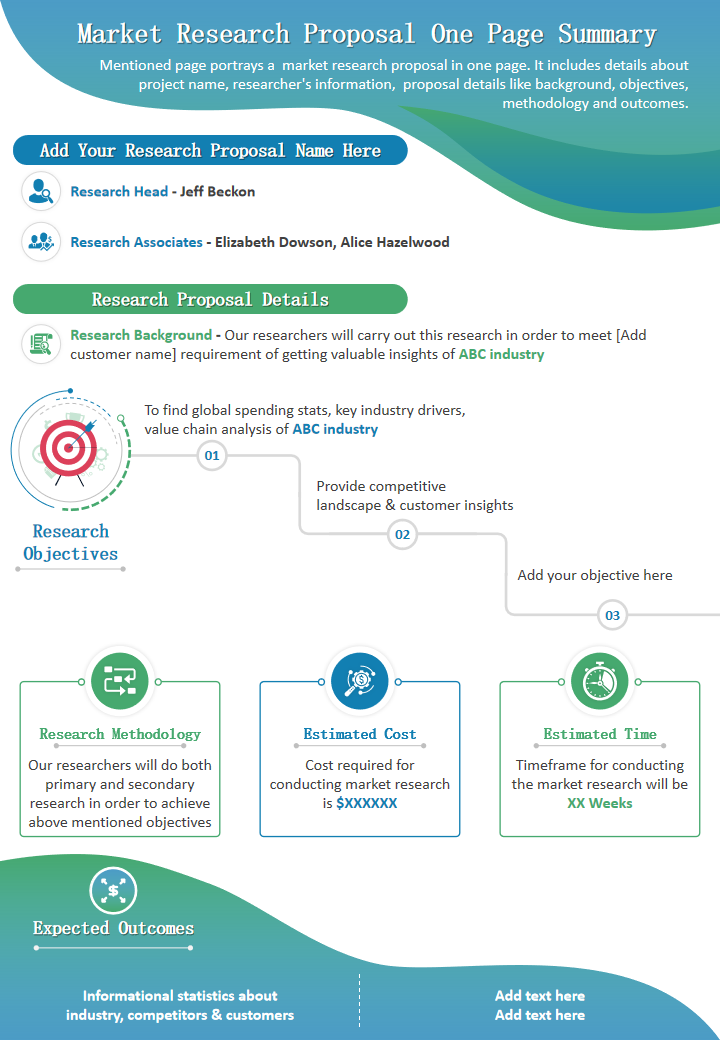
DOWNLOAD NOW
Template 2: Executive Summary Clinical Medicine Research Company Profile
For clinical medicine researchers, this layout provides a succinct yet comprehensive overview. The executive summary format communicates vital information, making it ideal for quickly understanding the research's significance. The slide depicts the company outline, critical statistics, and financial overview. The significant facts covered are the employee count, number of regulatory approvals, global market share, revenue CAGR, total revenue, and market capitalization. Elevate your clinical medicine research with an executive summary that encapsulates the essence of your findings and the potential impact on the medical landscape.
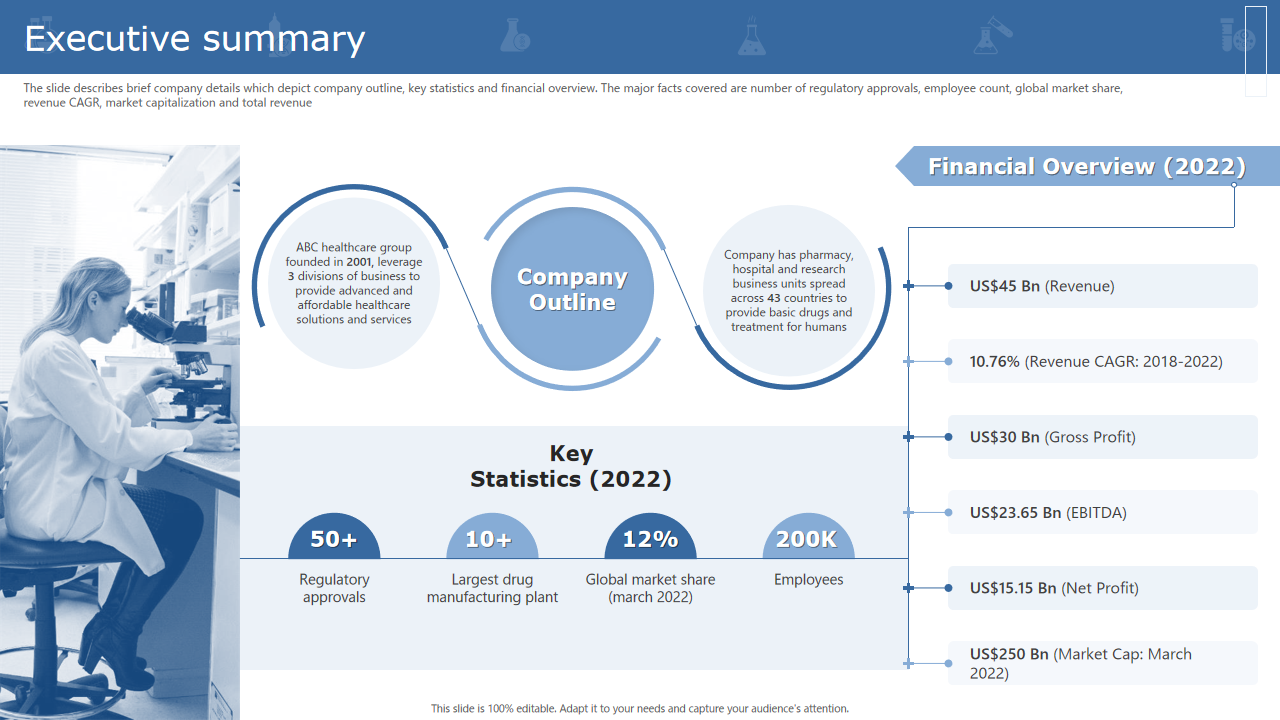
Template 3: Sample Research Paper Outline in One-Page Summary Report
This structure streamlines your detailed research paper into a digestible one-page summary. It breaks down the research paper's structure, ensuring the audience grasps vital points efficiently. It encapsulates five main sections: introduction, issue, literature review, recommendations, and conclusion. The easy-to-follow format makes it a valuable tool for presenting a complex research statement. Download this layout that transforms your detailed research paper into a one-page summary wonder, clearly presenting the structure and key points.

Template 4: One-Page Summary for Business Excellence Models Research Paper
Condense your exploration of business excellence models into a single, impactful page. This slide highlights the introduction, executive summary , company background, financial information, business excellence model used, key findings and insights, and conclusion, presenting them aesthetically pleasing. It's perfect for delivering the essence of your business excellence research with clarity and brevity. Condense your exploration of business excellence models into a single page, making your insights accessible and actionable.
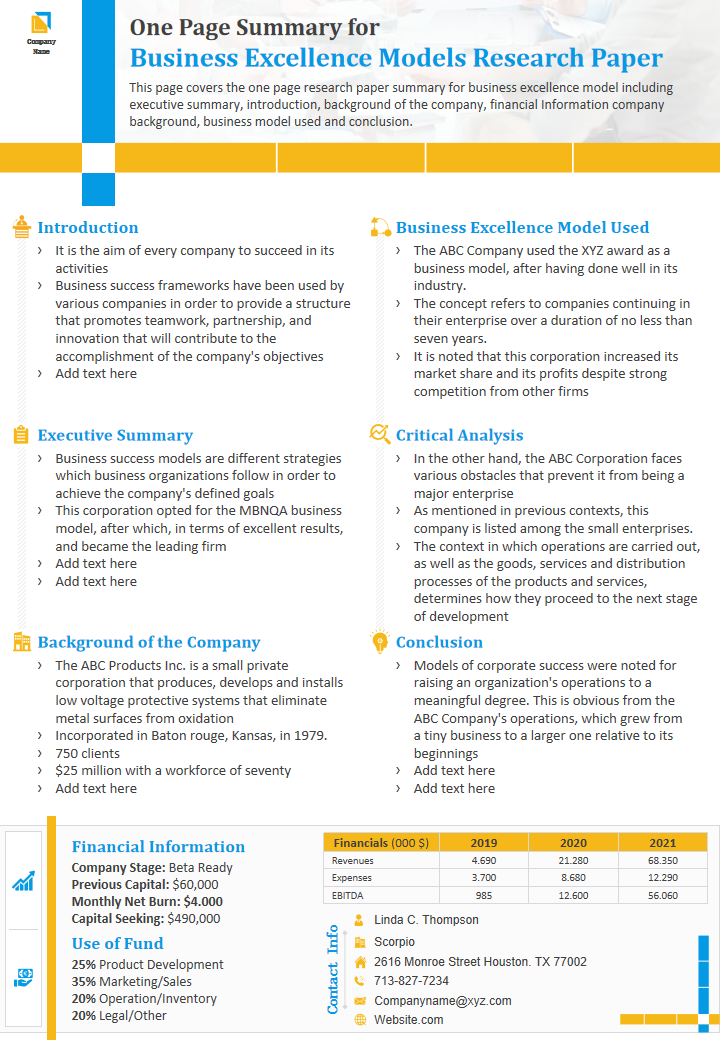
Template 5: One-Page Project Research Proposal Summary Presentation
Efficiently communicate the crux of your project research proposal with this preset. It highlights crucial components of your project research like objectives, study design, budget, project milestones and durations, etc. The one-page summary format ensures that your proposal's key elements are prominently featured. Visual elements enhance engagement, ensuring that key stakeholders swiftly grasp your project's significance. Download this layout and make it an excellent choice for a compelling project research presentation.
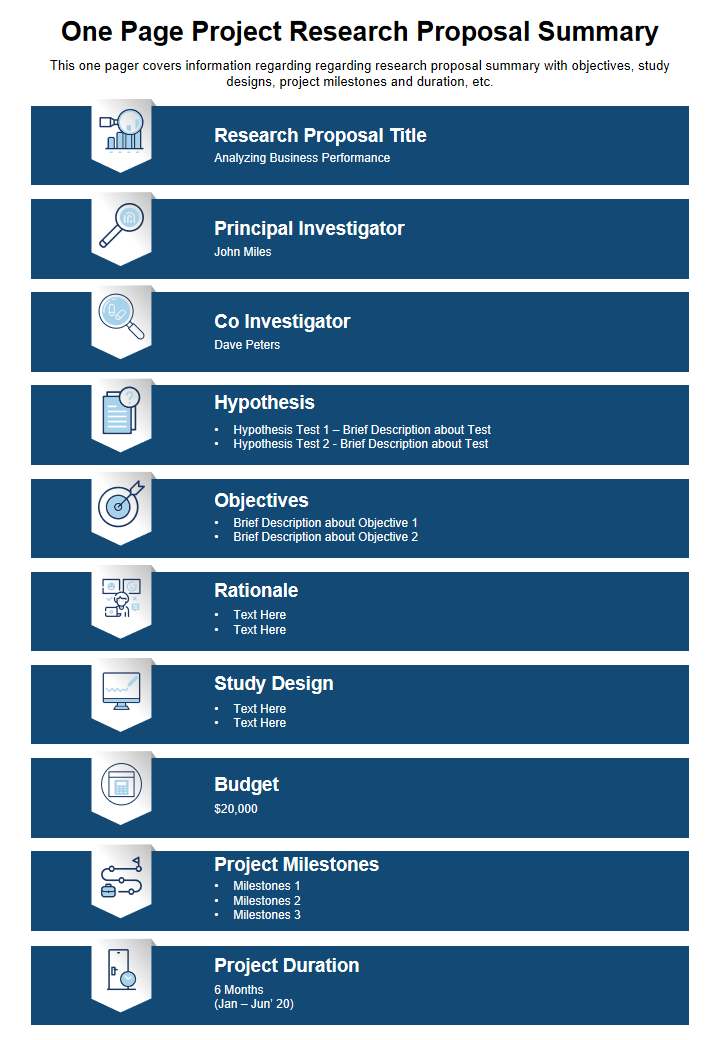
Template 6: One-Page Research Paper Summary on Business Ethics and Corruption
Navigate the complex landscape of business ethics and corruption research with this template. It condenses your research paper into a one-page summary , focusing on crucial ethical considerations:
- Introduction of the concept
- sources of corruption in businesses
- The legislative framework
- Principals of ethics
- Conclusion and
- Customer viewpoint
Clear visuals and a cohesive layout ensure that your insights on ethics and corruption are communicated effectively, giving your research statement the attention it deserves. Download this one-page summary , ensuring readers grasp your project's significance swiftly.
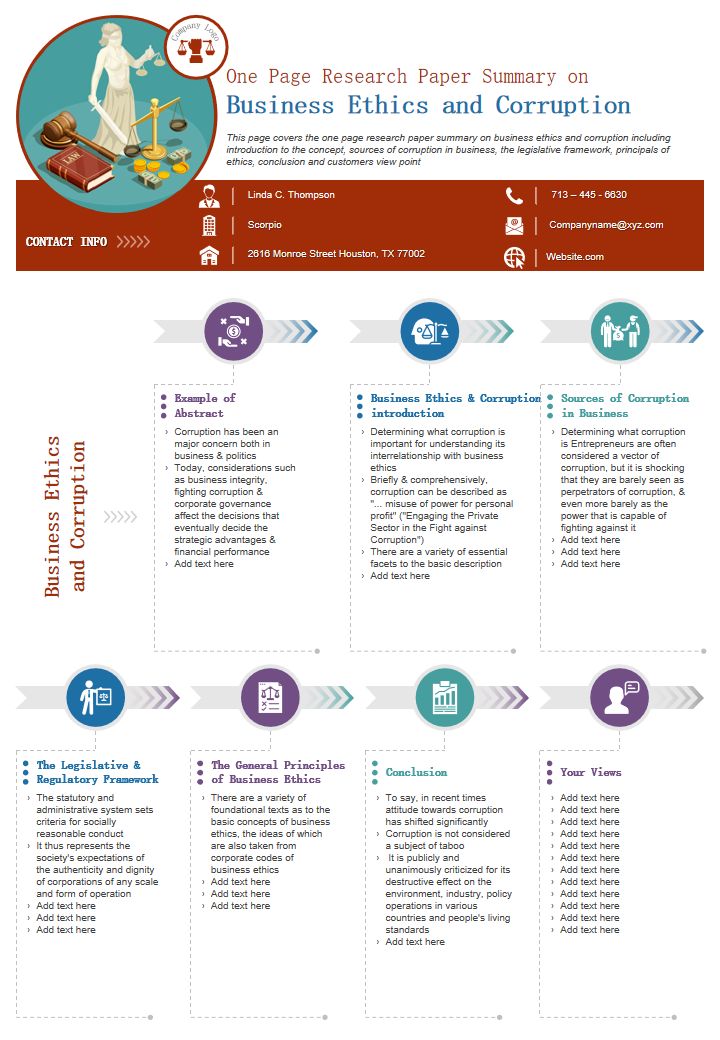
Template 7: Research Statement One Page Summary with Future Goals
Craft a compelling narrative of your research journey, culminating in a one-page summary with future goals. This presentation seamlessly integrates your research statement with a forward-looking perspective. It offers an overview of past and future research approaches and future goals to be achieved, along with a visual flowchart presenting your project research proposal , research activity, and other written content. Download this powerful tool for presenting your research's impact and future directions.
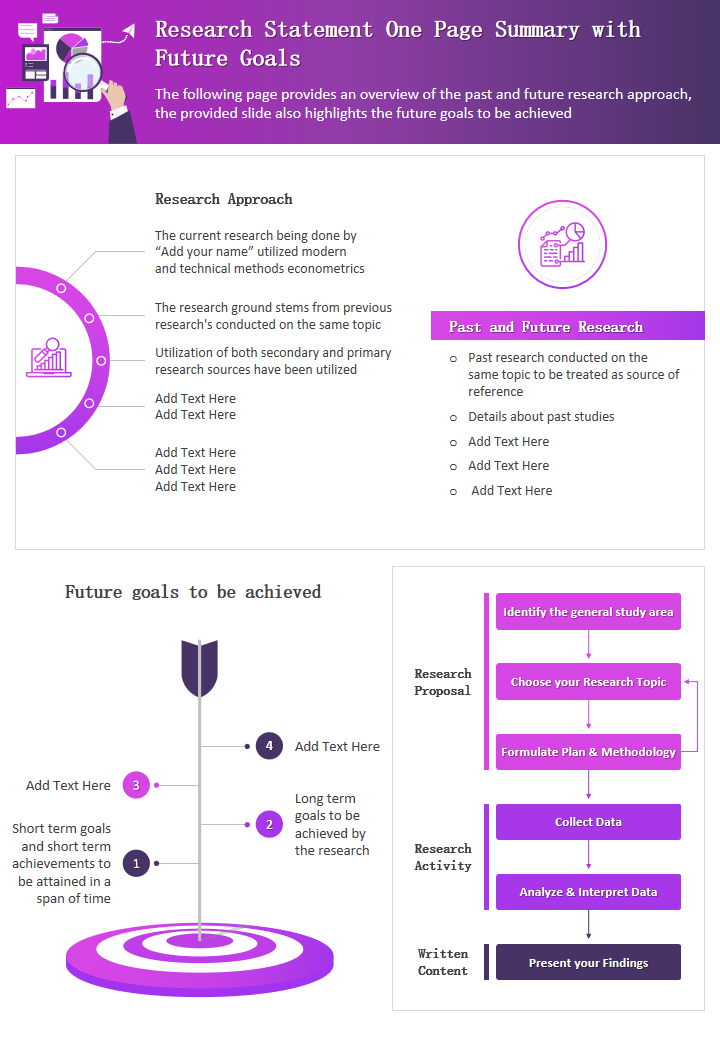
Conclusion: Your Research, Your Way
In the world of academia, business, or healthcare, your research is a cornerstone of progress. Ensure it's not just buried in volumes of data but presented in a way that captivates and communicates. Explore the above research summary templates and transform your research journey into a resonant narrative. Furthermore, dive into the past with our top history research proposal examples , complete with templates and samples for your historical research endeavors.
Remember, brevity is not just appreciated in a world saturated with information; it's often indispensable. So, here , you can streamline your project research proposals with our top 7 one-page templates for compelling and concise presentations.
Craft your research summary with care, and let your findings shine!
Related posts:
- Top 10 PowerPoint Templates to Present Succinct Research Statements
- How Financial Management Templates Can Make a Money Master Out of You
- [Updated 2023] Top 20 PowerPoint Templates to Devise a Systematic Research Methodology
- Top 10 Data Visualizations Playbook Templates with Samples and Examples
Liked this blog? Please recommend us

Top 10 Concrete Proposal Templates with Examples and Samples

Top 7 Risk Management Chart Templates with Examples and Samples
This form is protected by reCAPTCHA - the Google Privacy Policy and Terms of Service apply.

Digital revolution powerpoint presentation slides

Sales funnel results presentation layouts
3d men joinning circular jigsaw puzzles ppt graphics icons

Business Strategic Planning Template For Organizations Powerpoint Presentation Slides

Future plan powerpoint template slide

Project Management Team Powerpoint Presentation Slides

Brand marketing powerpoint presentation slides

Launching a new service powerpoint presentation with slides go to market

Agenda powerpoint slide show


Four key metrics donut chart with percentage

Engineering and technology ppt inspiration example introduction continuous process improvement

Meet our team representing in circular format

Have a thesis expert improve your writing
Check your thesis for plagiarism in 10 minutes, generate your apa citations for free.
- Knowledge Base
- Working with sources
- How to Write a Summary | Guide & Examples
How to Write a Summary | Guide & Examples
Published on 25 September 2022 by Shona McCombes . Revised on 12 May 2023.
Summarising , or writing a summary, means giving a concise overview of a text’s main points in your own words. A summary is always much shorter than the original text.
There are five key steps that can help you to write a summary:
- Read the text
- Break it down into sections
- Identify the key points in each section
- Write the summary
- Check the summary against the article
Writing a summary does not involve critiquing or analysing the source. You should simply provide an accurate account of the most important information and ideas (without copying any text from the original).
Instantly correct all language mistakes in your text
Be assured that you'll submit flawless writing. Upload your document to correct all your mistakes.

Table of contents
When to write a summary, step 1: read the text, step 2: break the text down into sections, step 3: identify the key points in each section, step 4: write the summary, step 5: check the summary against the article, frequently asked questions.
There are many situations in which you might have to summarise an article or other source:
- As a stand-alone assignment to show you’ve understood the material
- To keep notes that will help you remember what you’ve read
- To give an overview of other researchers’ work in a literature review
When you’re writing an academic text like an essay , research paper , or dissertation , you’ll integrate sources in a variety of ways. You might use a brief quote to support your point, or paraphrase a few sentences or paragraphs.
But it’s often appropriate to summarize a whole article or chapter if it is especially relevant to your own research, or to provide an overview of a source before you analyse or critique it.
In any case, the goal of summarising is to give your reader a clear understanding of the original source. Follow the five steps outlined below to write a good summary.
The only proofreading tool specialized in correcting academic writing
The academic proofreading tool has been trained on 1000s of academic texts and by native English editors. Making it the most accurate and reliable proofreading tool for students.

Correct my document today
You should read the article more than once to make sure you’ve thoroughly understood it. It’s often effective to read in three stages:
- Scan the article quickly to get a sense of its topic and overall shape.
- Read the article carefully, highlighting important points and taking notes as you read.
- Skim the article again to confirm you’ve understood the key points, and reread any particularly important or difficult passages.
There are some tricks you can use to identify the key points as you read:
- Start by reading the abstract . This already contains the author’s own summary of their work, and it tells you what to expect from the article.
- Pay attention to headings and subheadings . These should give you a good sense of what each part is about.
- Read the introduction and the conclusion together and compare them: What did the author set out to do, and what was the outcome?
To make the text more manageable and understand its sub-points, break it down into smaller sections.
If the text is a scientific paper that follows a standard empirical structure, it is probably already organised into clearly marked sections, usually including an introduction, methods, results, and discussion.
Other types of articles may not be explicitly divided into sections. But most articles and essays will be structured around a series of sub-points or themes.
Now it’s time go through each section and pick out its most important points. What does your reader need to know to understand the overall argument or conclusion of the article?
Keep in mind that a summary does not involve paraphrasing every single paragraph of the article. Your goal is to extract the essential points, leaving out anything that can be considered background information or supplementary detail.
In a scientific article, there are some easy questions you can ask to identify the key points in each part.
If the article takes a different form, you might have to think more carefully about what points are most important for the reader to understand its argument.
In that case, pay particular attention to the thesis statement —the central claim that the author wants us to accept, which usually appears in the introduction—and the topic sentences that signal the main idea of each paragraph.
Now that you know the key points that the article aims to communicate, you need to put them in your own words.
To avoid plagiarism and show you’ve understood the article, it’s essential to properly paraphrase the author’s ideas. Do not copy and paste parts of the article, not even just a sentence or two.
The best way to do this is to put the article aside and write out your own understanding of the author’s key points.
Examples of article summaries
Let’s take a look at an example. Below, we summarise this article , which scientifically investigates the old saying ‘an apple a day keeps the doctor away’.
An article summary like the above would be appropriate for a stand-alone summary assignment. However, you’ll often want to give an even more concise summary of an article.
For example, in a literature review or research paper, you may want to briefly summarize this study as part of a wider discussion of various sources. In this case, we can boil our summary down even further to include only the most relevant information.
Citing the source you’re summarizing
When including a summary as part of a larger text, it’s essential to properly cite the source you’re summarizing. The exact format depends on your citation style , but it usually includes an in-text citation and a full reference at the end of your paper.
You can easily create your citations and references in APA or MLA using our free citation generators.
APA Citation Generator MLA Citation Generator
Finally, read through the article once more to ensure that:
- You’ve accurately represented the author’s work
- You haven’t missed any essential information
- The phrasing is not too similar to any sentences in the original.
If you’re summarising many articles as part of your own work, it may be a good idea to use a plagiarism checker to double-check that your text is completely original and properly cited. Just be sure to use one that’s safe and reliable.
A summary is a short overview of the main points of an article or other source, written entirely in your own words.
Save yourself some time with the free summariser.
A summary is always much shorter than the original text. The length of a summary can range from just a few sentences to several paragraphs; it depends on the length of the article you’re summarising, and on the purpose of the summary.
With the summariser tool you can easily adjust the length of your summary.
You might have to write a summary of a source:
- As a stand-alone assignment to prove you understand the material
- For your own use, to keep notes on your reading
- To provide an overview of other researchers’ work in a literature review
- In a paper , to summarise or introduce a relevant study
To avoid plagiarism when summarising an article or other source, follow these two rules:
- Write the summary entirely in your own words by paraphrasing the author’s ideas.
- Reference the source with an in-text citation and a full reference so your reader can easily find the original text.
An abstract concisely explains all the key points of an academic text such as a thesis , dissertation or journal article. It should summarise the whole text, not just introduce it.
An abstract is a type of summary , but summaries are also written elsewhere in academic writing . For example, you might summarise a source in a paper , in a literature review , or as a standalone assignment.
Cite this Scribbr article
If you want to cite this source, you can copy and paste the citation or click the ‘Cite this Scribbr article’ button to automatically add the citation to our free Reference Generator.
McCombes, S. (2023, May 12). How to Write a Summary | Guide & Examples. Scribbr. Retrieved 14 May 2024, from https://www.scribbr.co.uk/working-sources/how-to-write-a-summary/
Is this article helpful?
Shona McCombes
Other students also liked, how to paraphrase | step-by-step guide & examples, how to quote | citing quotes in harvard & apa, apa referencing (7th ed.) quick guide | in-text citations & references.
- USC Libraries
- Research Guides
Organizing Your Social Sciences Research Paper
- Executive Summary
- Purpose of Guide
- Design Flaws to Avoid
- Independent and Dependent Variables
- Glossary of Research Terms
- Reading Research Effectively
- Narrowing a Topic Idea
- Broadening a Topic Idea
- Extending the Timeliness of a Topic Idea
- Academic Writing Style
- Applying Critical Thinking
- Choosing a Title
- Making an Outline
- Paragraph Development
- Research Process Video Series
- The C.A.R.S. Model
- Background Information
- The Research Problem/Question
- Theoretical Framework
- Citation Tracking
- Content Alert Services
- Evaluating Sources
- Primary Sources
- Secondary Sources
- Tiertiary Sources
- Scholarly vs. Popular Publications
- Qualitative Methods
- Quantitative Methods
- Insiderness
- Using Non-Textual Elements
- Limitations of the Study
- Common Grammar Mistakes
- Writing Concisely
- Avoiding Plagiarism
- Footnotes or Endnotes?
- Further Readings
- Generative AI and Writing
- USC Libraries Tutorials and Other Guides
- Bibliography
An executive summary is a thorough overview of a research report or other type of document that synthesizes key points for its readers, saving them time and preparing them to understand the study's overall content. It is a separate, stand-alone document of sufficient detail and clarity to ensure that the reader can completely understand the contents of the main research study. An executive summary can be anywhere from 1-10 pages long depending on the length of the report, or it can be the summary of more than one document [e.g., papers submitted for a group project].
Bailey, Edward, P. The Plain English Approach to Business Writing . (New York: Oxford University Press, 1997), p. 73-80 Todorovic, Zelimir William and Marietta Wolczacka Frye. “Writing Effective Executive Summaries: An Interdisciplinary Examination.” In United States Association for Small Business and Entrepreneurship. Conference Proceedings . (Decatur, IL: United States Association for Small Business and Entrepreneurship, 2009): pp. 662-691.
Importance of a Good Executive Summary
Although an executive summary is similar to an abstract in that they both summarize the contents of a research study, there are several key differences. With research abstracts, the author's recommendations are rarely included, or if they are, they are implicit rather than explicit. Recommendations are generally not stated in academic abstracts because scholars operate in a discursive environment, where debates, discussions, and dialogs are meant to precede the implementation of any new research findings. The conceptual nature of much academic writing also means that recommendations arising from the findings are distributed widely and not easily or usefully encapsulated. Executive summaries are used mainly when a research study has been developed for an organizational partner, funding entity, or other external group that participated in the research . In such cases, the research report and executive summary are often written for policy makers outside of academe, while abstracts are written for the academic community. Professors, therefore, assign the writing of executive summaries so students can practice synthesizing and writing about the contents of comprehensive research studies for external stakeholder groups.
When preparing to write, keep in mind that:
- An executive summary is not an abstract.
- An executive summary is not an introduction.
- An executive summary is not a preface.
- An executive summary is not a random collection of highlights.
Christensen, Jay. Executive Summaries Complete The Report. California State University Northridge; Clayton, John. "Writing an Executive Summary that Means Business." Harvard Management Communication Letter (July 2003): 2-4; Keller, Chuck. "Stay Healthy with a Winning Executive Summary." Technical Communication 41 (1994): 511-517; Murphy, Herta A., Herbert W. Hildebrandt, and Jane P. Thomas. Effective Business Communications . New York: McGraw-Hill, 1997; Vassallo, Philip. "Executive Summaries: Where Less Really is More." ETC.: A Review of General Semantics 60 (Spring 2003): 83-90 .
Structure and Writing Style
Writing an Executive Summary
Read the Entire Document This may go without saying, but it is critically important that you read the entire research study thoroughly from start to finish before you begin to write the executive summary. Take notes as you go along, highlighting important statements of fact, key findings, and recommended courses of action. This will better prepare you for how to organize and summarize the study. Remember this is not a brief abstract of 300 words or less but, essentially, a mini-paper of your paper, with a focus on recommendations.
Isolate the Major Points Within the Original Document Choose which parts of the document are the most important to those who will read it. These points must be included within the executive summary in order to provide a thorough and complete explanation of what the document is trying to convey.
Separate the Main Sections Closely examine each section of the original document and discern the main differences in each. After you have a firm understanding about what each section offers in respect to the other sections, write a few sentences for each section describing the main ideas. Although the format may vary, the main sections of an executive summary likely will include the following:
- An opening statement, with brief background information,
- The purpose of research study,
- Method of data gathering and analysis,
- Overview of findings, and,
- A description of each recommendation, accompanied by a justification. Note that the recommendations are sometimes quoted verbatim from the research study.
Combine the Information Use the information gathered to combine them into an executive summary that is no longer than 10% of the original document. Be concise! The purpose is to provide a brief explanation of the entire document with a focus on the recommendations that have emerged from your research. How you word this will likely differ depending on your audience and what they care about most. If necessary, selectively incorporate bullet points for emphasis and brevity. Re-read your Executive Summary After you've completed your executive summary, let it sit for a while before coming back to re-read it. Check to make sure that the summary will make sense as a separate document from the full research study. By taking some time before re-reading it, you allow yourself to see the summary with fresh, unbiased eyes.
Common Mistakes to Avoid
Length of the Executive Summary As a general rule, the correct length of an executive summary is that it meets the criteria of no more pages than 10% of the number of pages in the original document, with an upper limit of no more than ten pages [i.e., ten pages for a 100 page document]. This requirement keeps the document short enough to be read by your audience, but long enough to allow it to be a complete, stand-alone synopsis. Cutting and Pasting With the exception of specific recommendations made in the study, do not simply cut and paste whole sections of the original document into the executive summary. You should paraphrase information from the longer document. Avoid taking up space with excessive subtitles and lists, unless they are absolutely necessary for the reader to have a complete understanding of the original document. Consider the Audience Although unlikely to be required by your professor, there is the possibility that more than one executive summary will have to be written for a given document [e.g., one for policy-makers, one for private industry, one for philanthropists]. This may only necessitate the rewriting of the introduction and conclusion, but it could require rewriting the entire summary in order to fit the needs of the reader. If necessary, be sure to consider the types of audiences who may benefit from your study and make adjustments accordingly. Clarity in Writing One of the biggest mistakes you can make is related to the clarity of your executive summary. Always note that your audience [or audiences] are likely seeing your research study for the first time. The best way to avoid a disorganized or cluttered executive summary is to write it after the study is completed. Always follow the same strategies for proofreading that you would for any research paper. Use Strong and Positive Language Don’t weaken your executive summary with passive, imprecise language. The executive summary is a stand-alone document intended to convince the reader to make a decision concerning whether to implement the recommendations you make. Once convinced, it is assumed that the full document will provide the details needed to implement the recommendations. Although you should resist the temptation to pad your summary with pleas or biased statements, do pay particular attention to ensuring that a sense of urgency is created in the implications, recommendations, and conclusions presented in the executive summary. Be sure to target readers who are likely to implement the recommendations.
Bailey, Edward, P. The Plain English Approach to Business Writing . (New York: Oxford University Press, 1997), p. 73-80; Christensen, Jay. Executive Summaries Complete The Report. California State University Northridge; Executive Summaries. Writing@CSU. Colorado State University; Clayton, John. "Writing an Executive Summary That Means Business." Harvard Management Communication Letter , 2003; Executive Summary. University Writing Center. Texas A&M University; Green, Duncan. Writing an Executive Summary. Oxfam’s Research Guidelines series ; Guidelines for Writing an Executive Summary. Astia.org; Markowitz, Eric. How to Write an Executive Summary. Inc. Magazine, September, 15, 2010; Kawaski, Guy. The Art of the Executive Summary. "How to Change the World" blog; Keller, Chuck. "Stay Healthy with a Winning Executive Summary." Technical Communication 41 (1994): 511-517; The Report Abstract and Executive Summary. The Writing Lab and The OWL. Purdue University; Writing Executive Summaries. Effective Writing Center. University of Maryland; Kolin, Philip. Successful Writing at Work . 10th edition. (Boston, MA: Cengage Learning, 2013), p. 435-437; Moral, Mary. "Writing Recommendations and Executive Summaries." Keeping Good Companies 64 (June 2012): 274-278; Todorovic, Zelimir William and Marietta Wolczacka Frye. “Writing Effective Executive Summaries: An Interdisciplinary Examination.” In United States Association for Small Business and Entrepreneurship. Conference Proceedings . (Decatur, IL: United States Association for Small Business and Entrepreneurship, 2009): pp. 662-691.
- << Previous: 3. The Abstract
- Next: 4. The Introduction >>
- Last Updated: May 15, 2024 9:53 AM
- URL: https://libguides.usc.edu/writingguide

Research Summary
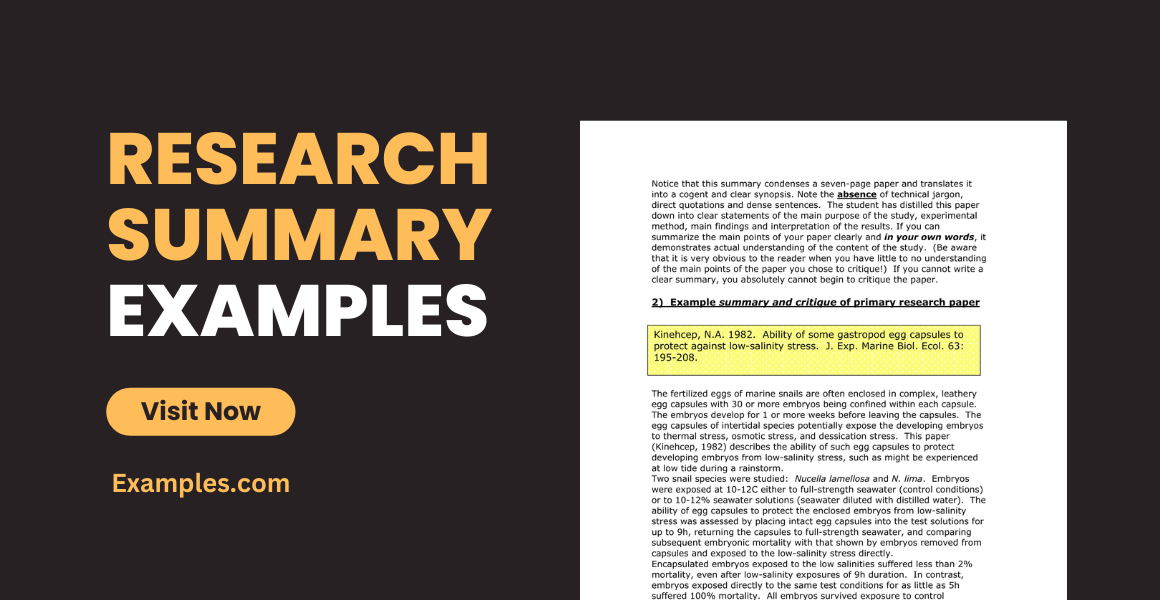
A research paper analyzes a perspective or argues a point. It is an expanded essay based on your interpretation, evaluation or argument about a certain topic.
According to Sunny Empire State College , “When you write a research paper you build upon what you know about the subject and make a deliberate attempt to find out what experts know. A research paper involves surveying a field of knowledge in order to find the best possible information in that field.” Whatever type of research paper you choose to write, it should present your own ideas backed with others’ (especially experts on the field) information and data.
Every research paper has a research summary. A research summary is a brief overview of what the whole research is about. It is a professional piece of writing that describes your research to the readers. It concisely yet perfectly captures the essence of the research as a whole. You may also see What Should Be in an Executive Summary of a Report?

Fundamentals of a Research Summary
Having a good template for a research summary is nothing if you don’t know its importance and basic function. Before you start writing your research summary, you should first know its fundamentals on the areas you need to pay attention to such as its content, style and organization.
- The content of your research summary must briefly discuss the techniques and tools used in the research and the importance of the research as a whole. Explain how the research can be of benefit for the people.
- To organize your research summary, each topic must be discussed in separate paragraphs. How you came up with a factual research must be briefly explained in a separate paragraph.
- If you have a lengthy research paper, try not to write not more than 10% of the entire paper. If it’s not as lengthy, you should not write more than 300 words in your summary.
However, rules may vary according to your research professor’s standards. This is just the basic fundamentals on how to write your research summary. Also see Thesis Outline Examples
How to Write a Research Summary
It is apparent that a research summary is a condensed version of the main idea of your research paper. Because of this, it is advised that the summary of your paper is written after you are done with your entire research. This is to ensure that all the added information in your research can be written in your summary as well and all of those that removed can be edited out. Here are a few steps on how to write a research summary:
Read your paper
It should be a fact you should know beforehand; the importance of reading your entire research paper thoroughly to write an effective research summary. Along the way, take notes of the important details and key findings that you want to highlight in your paper. This will help you organize your summary better. Remember that your research summary is a mini-paper of your study and it should contain the main ideas of your entire research.
Write a draft
For your first draft, focus on the content rather than the length of your summary. Your draft is your first outline on what to include in the final summary. Writing a draft ensures you write a clear, thorough and coherent summary of your research paper. Also see How to Write a Rough Outline
Identify main points
Within your research paper, you must identify the major points that will encourage prospective readers to go through your research paper. These major points must thoroughly and completely explain what the paper is trying to convey.
Separate sections
Identify the differences of the main section in your paper. Write a few sentences describing the main ideas of each section. In short, you should be able to present and thoroughly describe what each main section is focused on. It should have these basic sections:
- Introduction, brief opening statement
- Purpose of the study
- Data gathering method
- Summary of findings
- Description of recommendations with actual justification.
Combine Information
All the information you have gathered must be then used to make your summary. Remember that your summary is just an overview of your research paper as a whole. It should be not be more than 10% of your whole paper. Also see 5 Summary Writing Examples and Samples
Making The First Draft
After establishing the basic way of writing a research summary, it is a must to write a first draft. It should follow the flow of the original paper. Here’s a few steps on how to make a first draft:
First, state the research question in the introduction of your summary. This holds the ground as to the summary’s direction. Provide an explanation why your research is interesting and how it can help your target recipients.
Second, state the hypothesis you wish to prove. This will help you and your readers stay grounded on the topic at hand.
Third, briefly discuss the methodology used in your research. Discuss and describe the procedure, materials, participants, design, etc. The analysis of your data must also be included. You may also see How to Write a Successful Thesis Proposal
Fourth, describe the results and significance of your research. And lastly, briefly discuss the key implications of your research. The results and its interpretation should directly coincide with your hypothesis.

Editing your Research Summary
A research paper is a formal piece of writing. Your summary should be tailored to your expected readers. Say for example the prospective readers are your classmates, so the style of your paper should be clearly understood by them.
Eliminate wordiness. Avoid using unnecessary adjectives and adverbs. Write in a way it would be easier for your readers to understand. It is common for research papers to establish a word count. Avoid elongating your sentences when it has shorter versions.
Being vague in describing and explaining the points of your paper might lead to confusion in your readers part. Use specific, concrete language when presenting results. Use reliable and specific examples and references as well. You should also use scientifically accurate language to help support your claims. Avoid informal words and adjectives to describe the results of your research.
Paraphrase the information you want to include in your research paper. Direct quoting the information you have read from a different source is not oftenly used in formal writings. To give the exact credit for the information you paraphrased, follow the citation format required by your professor.
Reread your paper and let others read it as well. This way minor errors you were not able to notice can be quickly pointed out and corrected.
Research Summary Writing Tips
Your research summary should not be more than 10 pages long or not more than 10% of your original document. This keeps your research summary concise and compact. It should be short enough for your readers to read through but long enough for you to clearly explain your study.
Copy and paste
Avoid simply copy and pasting different parts of your paper into your summary. You should paraphrase parts that you want to include. As most research advisers read through all of your paper, it can easily be identified if you have copy-pasted parts from your research and might give you a bad grade.
Consider the readers
Although not a requirement from your professor, catering your summary to what the readers need is sometimes required. As some studies are given out to different influential people in the field, writing a summary that caters to the readers’ necessities might be required.
Research Article Summary Template
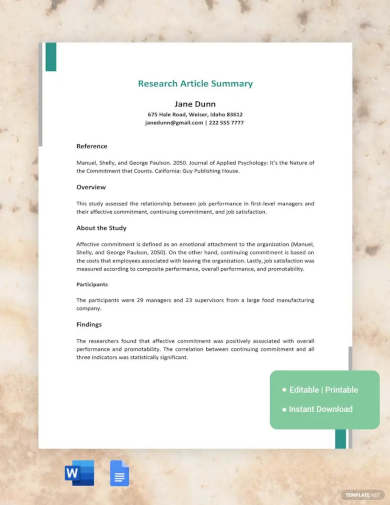
- Google Docs
Size: 158 KB
Research Report Executive Summary Template
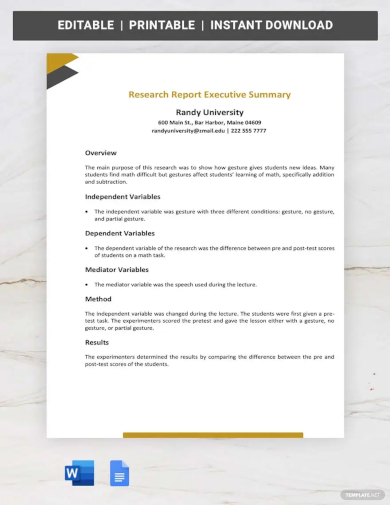
Size: 120 KB
Research Summary Example
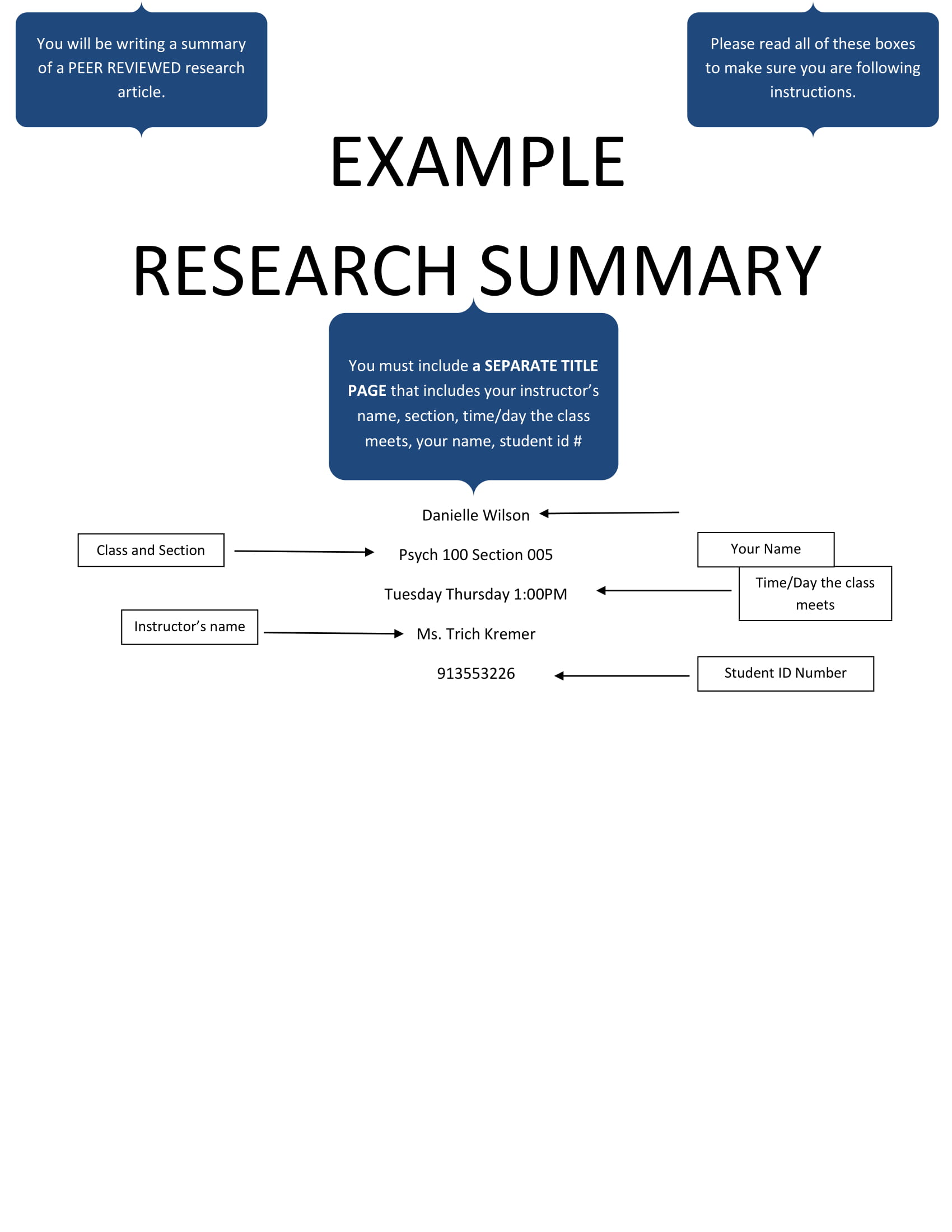
Size: 130 KB
Research Summary Sample
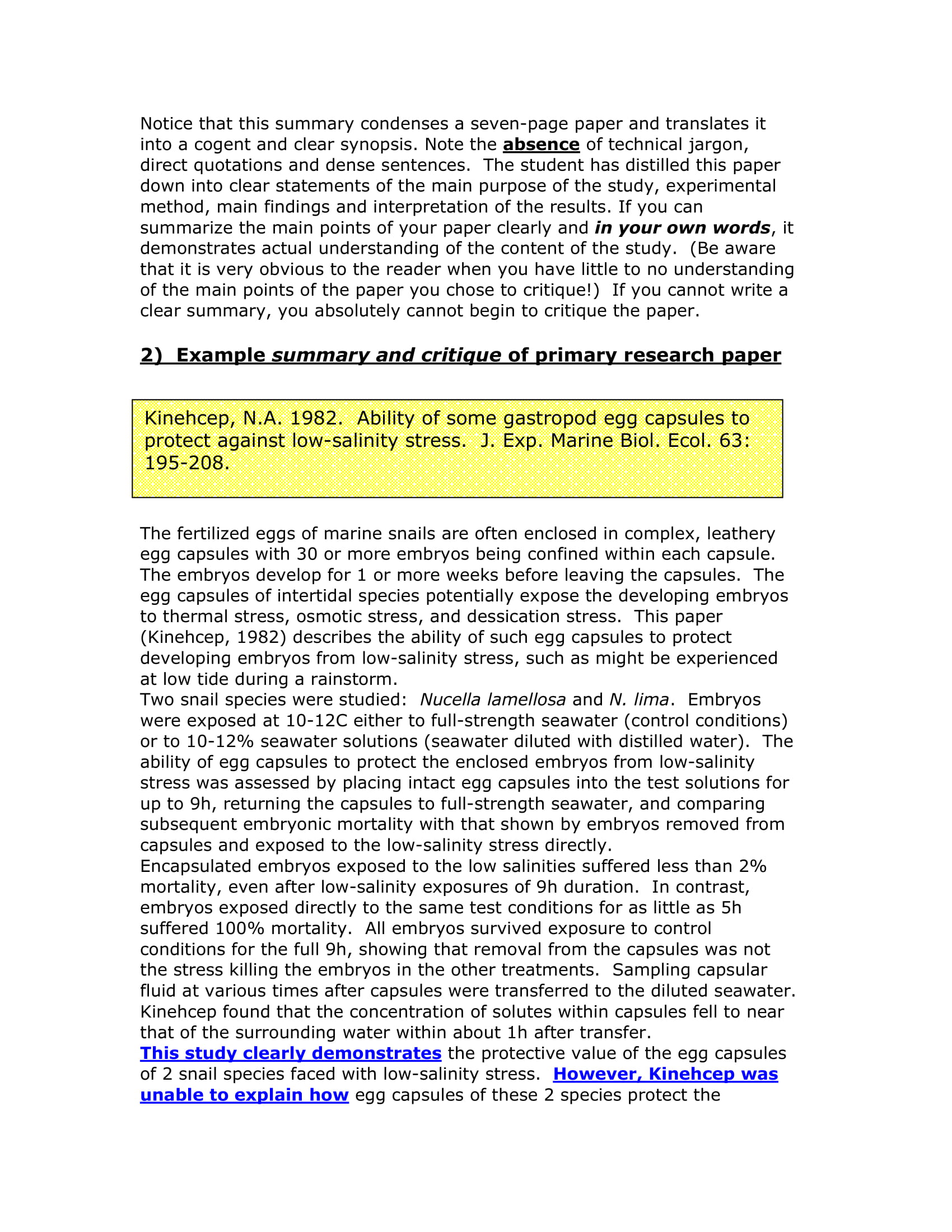
Size: 486 KB
Research Writing Summary Tips (continuation)
Clarity and organization.
One of the common mistakes in writing a research is publishing an unclear and unpolished summary. Bear in mind that your readers are likely reading about the topic of your research for the first time, avoid unclear and uncertain explanations and a disorganized summary.
Use strong and positive language
Use precise and strong words to help strengthen the foundation of your summary. Your summary should be able to stand alone despite it being a part of the research paper. Once you have convinced your readers with the recommendations regarding the topic of your paper, the readers should be able to find concrete evidence and explanations within your summary. Avoid pleas and biased statements in your summary, but make sure you are able to relay the sense of urgency for the recommendations you have given.
Divide into parts
To make things easier for you, divide your paper into different sections and headings, much like creating an outline. With this in mind, every point should be explained limited to its essence. In this way, you avoid writing too much information about your paper in your summary.
AI Generator
Text prompt
- Instructive
- Professional
10 Examples of Public speaking
20 Examples of Gas lighting
Research Paper Executive Summary Template
- Great for beginners
- Ready-to-use, fully customizable Doc
- Get started in seconds
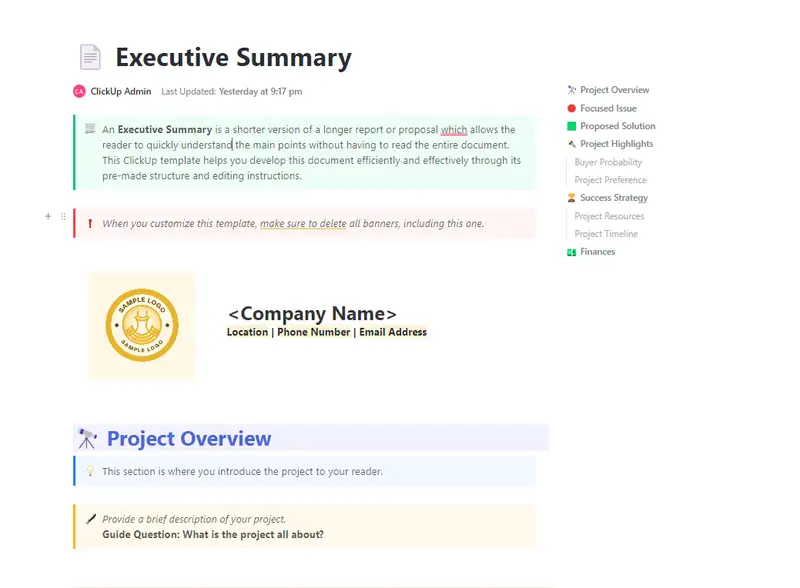
In the fast-paced world of research, it's crucial to communicate your findings quickly and effectively. That's where ClickUp's Research Paper Executive Summary Template comes in handy!
This template is designed to help you create a concise and impactful executive summary for your research paper by:
- Summarizing the key findings and results of your study
- Outlining the methodology and approach used in your research
- Highlighting the implications and potential impact of your findings
With ClickUp's Research Paper Executive Summary Template, you can save time and ensure that your research is easily understood by busy executives and decision-makers. Get started today and make your research stand out!
Benefits of Research Paper Executive Summary Template
When using the Research Paper Executive Summary Template in ClickUp, you'll experience the following benefits:
- Saves time by providing a pre-designed format for creating an executive summary
- Ensures consistency and professionalism in your research paper summaries
- Makes it easier for busy executives to quickly grasp the main findings and implications of your research
- Helps you effectively communicate the value and impact of your study
- Streamlines the process of creating executive summaries, allowing you to focus on the research itself
Main Elements of Research Paper Executive Summary Template
ClickUp's Research Paper Executive Summary template is designed to help you create professional and concise summaries of your research papers. Here are the main elements of this template:
- Doc Template: Use the pre-designed Research Paper Executive Summary template to easily structure and format your executive summary.
- Custom Statuses: Track the progress of your executive summary with custom statuses such as In Progress, Review, and Complete.
- Custom Fields: Add custom fields to capture important information about your research paper, such as Research Methodology, Key Findings, and Recommendations.
- Different Views: Access different views to review and collaborate on your executive summary, including the Document Outline view, where you can quickly navigate through different sections, and the Comments view, where you can easily leave and respond to feedback.
How to Use Executive Summary for Research Paper
Writing an executive summary for a research paper can be a daunting task, but with the help of ClickUp's Research Paper Executive Summary Template, you can simplify the process. Just follow these four steps to create a concise and impactful summary:
1. Understand the purpose and scope of your research
Before you begin writing your executive summary, it's important to have a clear understanding of the purpose and scope of your research paper. What problem are you addressing, and what key findings or conclusions did you arrive at? This will help you determine what information to include in your summary.
Use the Docs feature in ClickUp to review your research paper and identify the main points that need to be highlighted in the executive summary.
2. Craft a compelling introduction
Start your executive summary with a strong and engaging introduction that captures the reader's attention. Provide a brief overview of the research topic, its significance, and any relevant background information. Clearly state the main objective of your research and why it is important.
Utilize the custom fields in ClickUp to create a section for the introduction and ensure that it is well-crafted and impactful.
3. Summarize the key findings and conclusions
In this section, summarize the main findings and conclusions of your research paper. Highlight the most important results and insights that you have discovered. Be concise and use clear language to convey your key points. Avoid unnecessary technical jargon that may confuse the reader.
Use the custom fields in ClickUp to organize and prioritize the key findings and conclusions, ensuring that they are presented in a logical and coherent manner.
4. Provide recommendations and next steps
End your executive summary by providing recommendations based on your research findings. Offer practical suggestions for further action or areas that require further investigation. This shows the reader the potential impact and value of your research.
Create tasks in ClickUp to outline the recommendations and next steps, assigning them to relevant team members if necessary. This will help ensure that your research is put into action and that the necessary follow-up is carried out.
By following these four steps and utilizing ClickUp's Research Paper Executive Summary Template, you can effectively summarize your research paper in a clear and concise manner, allowing readers to quickly grasp the main points and understand the significance of your work.

Get Started with ClickUp’s Research Paper Executive Summary Template
Researchers and academics can use this Research Paper Executive Summary Template to create effective executive summaries for their research papers.
First, hit “Add Template” to sign up for ClickUp and add the template to your Workspace. Make sure you designate which Space or location in your Workspace you’d like this template applied.
Next, invite relevant members or guests to your Workspace to start collaborating.
Now you can take advantage of the full potential of this template to create impactful executive summaries:
- Use the Summary View to provide a concise overview of the key findings, methodology, and implications of the research
- The Visuals View will help you incorporate visual elements such as graphs or charts to enhance understanding
- Use the Recommendations View to provide actionable suggestions based on the research findings
- The References View will help you list all the sources and citations used in the research paper
- Customize the template by adding sections such as Introduction, Methodology, Results, and Conclusion
- Update the executive summary as you refine your research paper to ensure it accurately reflects the final version
- Review and proofread the executive summary to ensure clarity and coherence.
Related Templates
- Ui Designers Executive Summary Template
- Chemical Engineers Executive Summary Template
- Pharmaceutical Companies Executive Summary Template
- Food Business Executive Summary Template
- Information Professionals Executive Summary Template
Free forever with 100MB storage
Free training & 24-hours support
Serious about security & privacy
Highest levels of uptime the last 12 months
- Product Roadmap
- Affiliate & Referrals
- On-Demand Demo
- Integrations
- Consultants
- Gantt Chart
- Native Time Tracking
- Automations
- Kanban Board
- vs Airtable
- vs Basecamp
- vs MS Project
- vs Smartsheet
- Software Team Hub
- PM Software Guide

IMAGES
VIDEO
COMMENTS
So, follow the steps below to write a research summary that sticks. 1. Read the parent paper thoroughly. You should go through the research paper thoroughly multiple times to ensure that you have a complete understanding of its contents. A 3-stage reading process helps.
Table of contents. When to write a summary. Step 1: Read the text. Step 2: Break the text down into sections. Step 3: Identify the key points in each section. Step 4: Write the summary. Step 5: Check the summary against the article. Other interesting articles. Frequently asked questions about summarizing.
The summary section of your paper shows that you understood the basic facts of the research. The analysis shows that you can evaluate the evidence presented in the research and explain why the research could be important. Summary. The summary portion of the paper should be written with enough detail so that a reader would not have to look at ...
Research Summary. Definition: A research summary is a brief and concise overview of a research project or study that highlights its key findings, main points, and conclusions. It typically includes a description of the research problem, the research methods used, the results obtained, and the implications or significance of the findings.
A research summary template is also very likely to help you structure your paper. Sketch the main elements of the conclusion before writing it. Do this for a number of reasons: validate/invalidate hypotheses; enumerate key evidence supporting or invalidating them, list potential implications; mention the subject's importance; mention study ...
A research article usually has seven major sections: Title, Abstract, Introduction, Method, Results, Discussion, and References. The first thing you should do is to decide why you need to summarize the article. If the purpose of the summary is to take notes to later remind yourself about the article you may want to write a longer summary ...
1. Scan and extract the main points. First things first, so you have to read the paper. But that doesn't mean you have to read it from start to finish. Start by scanning the article for its main points. Here's the essential information to extract from the research paper you have in front of you: Authors, year, doi.
A summary must be coherent and cogent and should make sense as a stand-alone piece of writing. It is typically 5% to 10% of the length of the original paper; however, the length depends on the length and complexity of the article and the purpose of the summary. Accordingly, a summary can be several paragraphs or pages, a single paragraph, or ...
The template structure reflects the overall research process, ensuring your paper will have a smooth, logical flow from chapter to chapter. The research paper template covers the following core sections: The title page/cover page; Abstract (sometimes also called the executive summary) Section 1: Introduction Section 2: Literature review
1. Determine the focus of your summary. Draft a research paper summary in minutes with Paperpal. Click here to start writing! 2. Invest enough time to understand the topic deeply. 3. Keep the summary crisp, brief and engaging. Use Paperpal to summarize your research paper.
A research paper outline is a useful tool to aid in the writing process, ... Summary of figures and relationship with recent immunization debate; ... Research Paper Format | APA, MLA, & Chicago Templates The formatting guidelines for a research paper differ by style guide. Download free templates to get started.
When writing a summary, the goal is to compose a concise and objective overview of the original article. The summary should focus only on the article's main ideas and important details that support those ideas. ... Adapted from "Guidelines for Using In-Text Citations in a Summary (or Research Paper)" by Christine Bauer-Ramazani, 2020 ...
E. Research Methodology (Summary) In paragraph form, describe the basic elements of your research design. Use words that lay practitioners will understand. Word Limit: About 200 words for each separate experiment or study that is described (up to 500 words if three or more experiments or separate studies were conducted).
Template 6: One-Page Research Paper Summary on Business Ethics and Corruption. Navigate the complex landscape of business ethics and corruption research with this template. It condenses your research paper into a one-page summary, focusing on crucial ethical considerations: Introduction of the concept.
Table of contents. When to write a summary. Step 1: Read the text. Step 2: Break the text down into sections. Step 3: Identify the key points in each section. Step 4: Write the summary. Step 5: Check the summary against the article. Frequently asked questions.
Revised on July 23, 2023. We have designed several free templates to help you get started on a variety of academic topics. These range from formatting your thesis or dissertation to writing a table of contents or a list of abbreviations. We also have templates for various citation styles, including APA (6 and 7), MLA, and Chicago.
Below is a template for an executive summary that you can use to draft your own: Introduction: [Describe the business, its purpose and the problems addressed by the research paper.] Purpose: [Describe the purpose of the research paper.] Methodology: [List the data collection methods used in the research study.]
Scholarcy's AI summarization tool is designed to generate accurate, reliable article summaries. Our summarizer tool is trained to identify key terms, claims, and findings in academic papers. These insights are turned into digestible Summary Flashcards. Scroll in the box below to see the magic ⤸. The knowledge extraction and summarization ...
Re-read your Executive Summary After you've completed your executive summary, let it sit for a while before coming back to re-read it. Check to make sure that the summary will make sense as a separate document from the full research study. By taking some time before re-reading it, you allow yourself to see the summary with fresh, unbiased eyes.
RESEARCH SUMMARY . Danielle Wilson . Psych 100 Section 005 . Tuesday Thursday 1:00PM . Ms. Trich Kremer . 913553226 . Student ID Number You will be writing a summary of a PEER REVIEWED research article. Instructor's name Time/Day the class meets Class and Section Your Name Please read all of these boxes to make sure you are following ...
Every research paper has a research summary. A research summary is a brief overview of what the whole research is about. It is a professional piece of writing that describes your research to the readers. ... Fundamentals of a Research Summary. Having a good template for a research summary is nothing if you don't know its importance and basic ...
This template is designed to help you create a concise and impactful executive summary for your research paper by: Summarizing the key findings and results of your study. Outlining the methodology and approach used in your research. Highlighting the implications and potential impact of your findings. With ClickUp's Research Paper Executive ...
4. Choose the Right Report Template: Utilize templates tailored to your report type, whether it's annual, weekly, project-related, sales/marketing, research, or academic. Templates streamline formatting and enhance professionalism. Visme has hundreds of report templates to choose from. Browse the gallery to find the perfect one. 5.
Prior to GPT-4o, you could use Voice Mode to talk to ChatGPT with latencies of 2.8 seconds (GPT-3.5) and 5.4 seconds (GPT-4) on average. To achieve this, Voice Mode is a pipeline of three separate models: one simple model transcribes audio to text, GPT-3.5 or GPT-4 takes in text and outputs text, and a third simple model converts that text back to audio.
Access the portal of NASS, the official source of agricultural data and statistics in the US, and explore various reports and products.